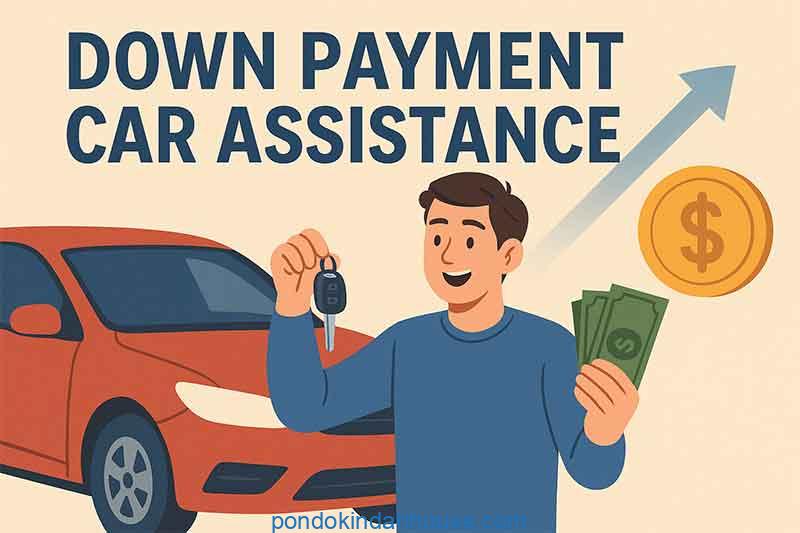Down Payment Car Assistance: How It Works and How to Make the Most of It

Buying a car is one of the biggest financial commitments most people make. For many, the biggest obstacle isn’t the monthly payment but the initial cash required upfront — the down payment. That’s where down payment car assistance comes in.
If you’ve heard of programs that help with car down payments but aren’t sure how they work, whether they’re legitimate, or how to find one that fits your situation, this article is for you. Let’s dive deep into what down payment assistance really means, how it benefits you, and what you should watch out for before signing any paperwork.
What Is Down Payment Car Assistance?
Down payment car assistance refers to a financial aid program that helps car buyers cover part or all of their required down payment when purchasing a vehicle. The assistance can come from various sources, including dealerships, lenders, government programs, nonprofits, or even special promotional campaigns.
Normally, a down payment is a percentage of the car’s total price — usually between 10% and 20% — that you pay upfront before the remaining balance is financed through a loan. It helps reduce your loan amount, lowers your monthly payments, and increases your chances of loan approval.
However, not everyone can afford a large lump sum, especially first-time buyers or people recovering from financial setbacks. Down payment assistance programs are designed to bridge that gap by offering partial funding, zero-down options, or short-term loans specifically for the down payment itself.
In simple terms, these programs make car ownership more accessible to those who might otherwise have to delay or give up their purchase.
Why Down Payments Are So Important
Understanding the role of a down payment helps you see why assistance programs matter. A down payment serves three main purposes.
First, it shows commitment. When you contribute money upfront, lenders and dealers see that you’re financially invested in the vehicle. That lowers their risk, which can lead to better loan terms or interest rates.
Second, it reduces your monthly payment. The higher your down payment, the smaller the remaining balance you need to finance. That means less debt and less interest paid over time.
Third, it prevents negative equity. Cars lose value quickly. If you finance 100% of the purchase, your loan balance might exceed the car’s market value within months. A down payment helps buffer that depreciation.
Yet, while the benefits are clear, many buyers struggle to come up with several thousand dollars upfront. That’s where down payment car assistance becomes invaluable.
How Down Payment Car Assistance Programs Work
Although the details vary depending on the provider, the basic structure of down payment assistance programs follows a similar pattern.
Step 1: Application and Qualification
You begin by applying for a program through a dealership, lender, or dedicated assistance organization. The provider reviews your credit history, employment status, and income level to determine eligibility.
Some programs are tailored to specific groups, such as first-time buyers, low-income households, veterans, or people with subprime credit. Others are open to anyone who meets minimum financial requirements.
Step 2: Funding the Down Payment
Once approved, the program contributes a set amount toward your down payment. This could be a direct cash grant, a zero-interest loan, or a credit applied to your purchase agreement.
For example, a dealership might offer $1,000 toward your down payment if you finance the vehicle through them. Another program might provide a short-term loan to cover your portion, allowing you to repay it over a few months instead of all at once.
Some government-backed initiatives even provide grants that don’t need to be repaid, though these are more common for housing than for vehicles.
Step 3: Vehicle Purchase and Financing
After funding is secured, you proceed with the car purchase just like any other buyer. The dealership applies the assistance amount to your contract, reducing the upfront cost you need to pay.
You’ll still sign a financing agreement for the remaining balance, and depending on the structure of the assistance, you may have a separate repayment plan for the portion that was covered.
Step 4: Ongoing Payment and Obligations
Once your car is financed, you’ll begin making your monthly payments. If the down payment assistance was a loan, you’ll also make repayments toward that portion as scheduled.
It’s crucial to understand every term before you sign — including interest rates, repayment schedules, and any penalties for late payments. Transparency is key to making sure the program actually benefits you.
Common Types of Down Payment Car Assistance
There isn’t just one kind of assistance. Here are the most common types you’ll find today.
1. Dealership Assistance Programs
Many car dealerships run promotional campaigns where they contribute part of your down payment. It’s often structured as a rebate or credit applied directly to your purchase.
These programs can be a win-win. The dealership sells more vehicles, and buyers get relief on their upfront costs. However, the offers may come with specific conditions such as financing through the dealer’s preferred lender or purchasing select models.
2. Lender-Sponsored Assistance
Some lenders, especially credit unions and community banks, offer down payment aid as part of their auto loan packages. This might come as an incentive for new customers or for borrowers with steady income but limited savings.
3. Trade-In Bonuses
Instead of traditional assistance, some dealerships offer trade-in bonuses that act as a substitute for cash down payments. If your old car’s value isn’t enough, they might add an extra amount to bridge the gap.
4. Employer or Community Programs
Certain employers, unions, or community organizations provide financial assistance for vehicle purchases, especially for essential workers who rely on transportation.
5. Manufacturer Incentives
Occasionally, car manufacturers themselves offer national or regional promotions that lower the down payment requirement. These are usually tied to special financing offers or seasonal sales events.
Benefits of Down Payment Car Assistance
The main appeal of these programs is simple — they make buying a car easier. But the benefits go beyond that.
Easier Access to Financing
When your down payment is taken care of, you stand a better chance of getting loan approval, even if your credit isn’t perfect. Lenders are more likely to approve applications where the buyer has some form of equity in the car, even if it’s funded by a third party.
Lower Financial Stress
Saving up thousands of dollars can take months or even years. Down payment assistance reduces that wait and helps you get behind the wheel sooner.
Opportunity to Buy a Better Vehicle
With help on the upfront cost, you might be able to afford a newer or more reliable model instead of settling for an older car that could require frequent repairs.
Potential to Rebuild Credit
If you’re rebuilding your financial profile, financing a car responsibly — even with assistance — can help strengthen your credit score over time. Consistent, on-time payments are key.
Risks and Things to Watch Out For
Like any financial arrangement, down payment car assistance isn’t perfect. It’s important to know what you’re getting into.
Higher Overall Cost
If the assistance is structured as a loan, you’ll eventually pay interest on that money. This could make the total cost of your car higher than if you had paid the down payment yourself.
Limited Vehicle Selection
Some programs restrict your choice of car to certain models or price ranges. Always check the terms before committing.
Hidden Fees or Conditions
Promotional offers can sometimes hide requirements, such as mandatory warranties or higher interest rates. Don’t assume every “zero-down” deal is free money — always read the fine print.
Negative Equity Risk
Cars depreciate fast. If your loan covers nearly the full value of the vehicle, you could owe more than the car is worth after a few months. To avoid this, choose vehicles that retain value well and avoid overly long loan terms.
Eligibility Restrictions
Not everyone qualifies for assistance. Programs often target specific income brackets or employment statuses, so check if you meet the requirements before applying.
How to Qualify for Down Payment Car Assistance
While requirements vary, most programs look at a few common factors.
They’ll typically check your income level and stability to ensure you can handle future payments. Even though assistance helps with the upfront cost, lenders still want assurance that you can maintain the loan.
Credit history also matters, though some programs are designed for buyers with less-than-perfect credit. In such cases, the lender may offset the risk with slightly higher interest rates.
Proof of residence and employment are usually required, along with valid identification and a current driver’s license.
For specific programs, like those sponsored by local governments or nonprofits, you might need to meet additional criteria, such as being a first-time car buyer or a resident of a particular area.
How to Find Down Payment Car Assistance Near You
If you’re interested in exploring your options, start with local dealerships. Ask if they have active down payment programs or if they partner with any lenders that do.
You can also check credit unions, especially community-based ones, as they often have flexible lending policies and localized incentives.
Online marketplaces and auto finance comparison sites can help you find nationwide programs, especially during promotional periods.
Lastly, don’t underestimate social and community organizations. Some nonprofits partner with lenders to help essential workers, students, or low-income families obtain affordable vehicles.
Tips for Using Down Payment Car Assistance Wisely
To make sure you truly benefit from the program, a few key practices can help.
First, understand every cost involved. Even if the down payment is covered, make sure your monthly payments fit comfortably within your budget.
Second, avoid financing more than you need. Some buyers are tempted to upgrade to a pricier car since the upfront burden feels lighter. This can backfire if the loan becomes difficult to manage.
Third, maintain good payment habits. Missing payments can quickly damage your credit and risk repossession, especially if your loan terms are strict.
Fourth, choose a reliable car. The last thing you need is a breakdown and costly repairs on top of monthly payments. Always inspect or have the vehicle checked by a professional before signing any agreement.
Lastly, keep all documents and receipts related to the assistance program. If any disputes or misunderstandings arise, you’ll have proof of what was promised.
Who Should Consider Down Payment Assistance?
These programs are ideal for buyers who have a steady income but limited savings. If you can comfortably handle monthly payments yet struggle with upfront costs, down payment car assistance can be a good solution.
It’s also useful for people rebuilding credit after financial difficulties. Many lenders are open to working with subprime borrowers if they can show consistent income and responsible behavior.
However, if your income is unstable or you already have significant debt, it may be wiser to delay purchasing a car until your financial situation improves. Assistance programs make buying easier, but they don’t eliminate the long-term responsibilities of ownership.
Alternatives to Down Payment Car Assistance
If you don’t qualify for formal assistance, there are other strategies you can consider.
Some credit unions allow low or zero-down loans for members with good credit. Others may let you roll part of your down payment into the financing if your credit profile supports it.
Leasing is another option. It usually requires a smaller upfront payment and lets you drive a newer car every few years.
You can also explore co-signing with a trusted family member or friend who has a stronger credit score, which may help secure better loan terms and reduce the required down payment.
Finally, consider saving strategies like setting aside a small amount each month or selling unused assets to build your down payment fund gradually.
Final Thoughts
Down payment car assistance programs can be a real game changer for many buyers. They make car ownership more attainable, ease financial pressure, and can even help those with challenging credit situations get approved for financing.
But like any financial tool, they come with responsibilities. You need to read the fine print, understand your repayment obligations, and ensure the overall cost fits your budget.
The goal isn’t just to get a car — it’s to own it responsibly, without putting yourself in financial stress.
If used wisely, down payment car assistance can open the door to new opportunities — whether that means better mobility, greater job access, or simply more independence on the road.
Take the time to research your options, compare offers, and ask questions. With the right program and a clear understanding of the terms, your dream car might be closer than you think.
Related Posts:




